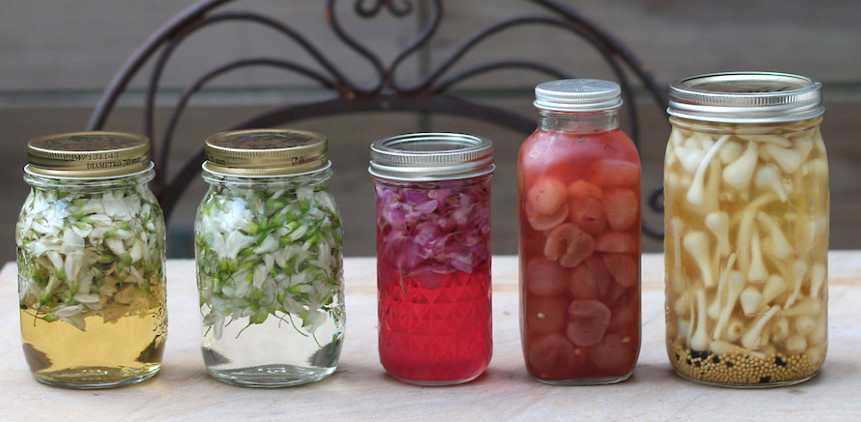The issue you are reading spans the most extreme months of the foraging year: February through April see the wild foods pendulum arcing vastly from nothing to everything, bare and brown to bursting with green.
Over the winter, foragers have been eking out the preserved wild plant profits of the previous year, being stingy enough that we don’t find ourselves in the panic place of No Supplies before spring’s gathering can begin.
In my house, last summer’s elderflower and milkweed cordials, wild black cherry and sumac fizz — drinks whose gassy levity is amplified by outdoor drinking — months ago gave way to earthier amber-tinted sumac vodka, brown sweetfern bourbon and purple beach plum gin. But by February, when winter seems endless, my inner Siberian has been conjured, appearing fur-hatted and stamping the West 127th Street frost off his feet, demanding pale glassesful of clear spirits, viscously cold, austerely alcoholic.
And with him is awakened an appetite for the provender harvested and preserved by pickling almost a year ago — vinegary, briny zakuski, the small bite to accompany the fire sliding down the winter-tired throat.
Pickling is the easiest way to preserve big flavors for a thin season. One of the best martinis I know is several slugs of good, thickly cold vodka, a dirty splash of field garlic pickling brine and two of the pickled bulbs dropped into the eddy created by the cocktail-pour. Seep zat, my frigid friend, ent varm yourself een my parlor.
The sharp little wild onions are wonderful with cold and smoked meats, or caviar, too (as if, and I wish).
I can be profligate with these pickles—because more are on the way. Winter despair is staved off by experience: Field garlic season approaches. The invasive weed’s green chive spikes appear early, through snow and brown leaf litter. They can be collected at any time, but after many years I’ve learned that late April through May yield the fattest, firmest bulbs.
It is best to sort them as you gather, saving you from a muddy mess at home. Don’t yank out a whole clump, or you’ll be stuck separating the maddeningly tiny bulbs, like rice grains, from the choice thumbnail-size ones forever. Instead, choose only the most prominent leaves in a bunch, grab them very close to the base and pull, giving several firm tugs to release them from the soil. Shake well to dislodge any earth. Pick oodles more than you think you will need; they are worth the work, and you will want to keep some to eat fresh, too.
At home, cut the bulbs from the greens (which you should turn into field garlic oil and green salt) and wash in several changes of water, pulling off any loose skin. Now they are ready to pickle.
For extra heat in my glass I turn to Japanese knotweed (Polygonum cuspidatum — a serious invasive plant). I pickle the sour slices with crumbled, dried chilies. In the city their shoots emerge from late March to early April, depending on climates large and small. Sliced into rounds and packed into pickling jars, their vivid green soon turns to khaki mud, but their tart crispness is undiminished, even years later. You will congratulate yourself on the pep in next winter’s cocktails.
For a gentler drink, I turn to flowers. Last May I collected black locust (Robinia pseudoacacia) blossoms from a tall tree dripping with them; they were heavenly sweet. With some, I made vinegar the long way round (a mother, many months, many fruit flies, it’s still maturing). Others, I pickled in a white wine vinegar solution, with a heavy hand on the sugar. The rest I covered in gin, which was strained after a week, to prevent it turning too tannic. That gin, a few drops of Chartreuse (yellow) and the pickled flowers as garnish make a cocktail which makes our Harlem nights sparkle a little more than they might as we draw the curtains on our cold evening and wait for greener things to come.
Photo credit: Vincent Mounier and Marie Viljoen



